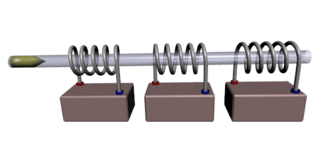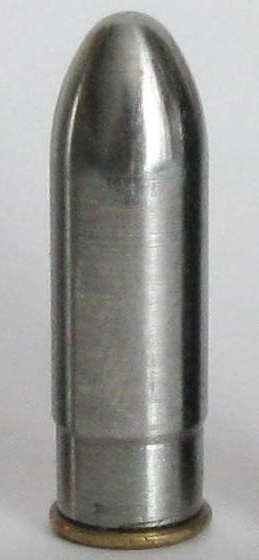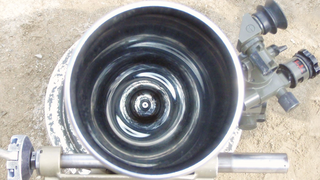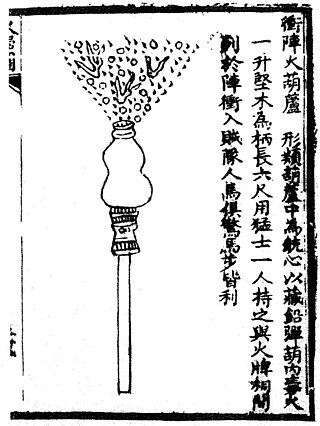
A firearm is any type of gun that uses an explosive charge and is designed to be readily carried and operated by an individual. The term is legally defined further in different countries.

A cartridge, also known as a round, is a type of pre-assembled firearm ammunition packaging a projectile, a propellant substance and an ignition device (primer) within a metallic, paper, or plastic case that is precisely made to fit within the barrel chamber of a breechloading gun, for convenient transportation and handling during shooting. Although in popular usage the term "bullet" is often used to refer to a complete cartridge, the correct usage only refers to the projectile.

An air gun or airgun is a gun that uses energy from compressed air or other gases that are mechanically pressurized and then released to propel and accelerate projectiles, similar to the principle of the primitive blowgun. This is in contrast to a firearm, which shoots projectiles using energy generated via exothermic combustion (detonation) of chemical propellants, most often black powder or smokeless powder.

A coilgun is a type of mass driver consisting of one or more coils used as electromagnets in the configuration of a linear motor that accelerate a ferromagnetic or conducting projectile to high velocity. In almost all coilgun configurations, the coils and the gun barrel are arranged on a common axis. A coilgun is not a rifle as the barrel is smoothbore.

Caseless ammunition (CL), or caseless cartridge, is a configuration of weapon-cartridge that eliminates the cartridge case that typically holds the primer, propellant and projectile together as a unit. Instead, the propellant and primer are fitted to the projectile in another way so that a cartridge case is not needed, for example inside or outside the projectile depending on configuration.

A smoothbore weapon is one that has a barrel without rifling. Smoothbores range from handheld firearms to powerful tank guns and large artillery mortars.

A gun barrel is a crucial part of gun-type weapons such as small firearms, artillery pieces, and air guns. It is the straight shooting tube, usually made of rigid high-strength metal, through which a contained rapid expansion of high-pressure gas(es) is used to propel a projectile out of the front end (muzzle) at a high velocity. The hollow interior of the barrel is called the bore, and the diameter of the bore is called its caliber, usually measured in inches or millimetres.

The .22 Long Rifle, also known as the .22LR or 5.7×15mmR, is a long-established variety of .22 caliber rimfire ammunition originating from the United States. It is used in a wide range of firearms including rifles, pistols, revolvers, and submachine guns.

The Gyrojet is a family of unique firearms developed in the 1960s named for the method of gyroscopically stabilizing its projectiles. Rather than inert bullets, Gyrojets fire small rockets called Microjets which have little recoil and do not require a heavy barrel or chamber to resist the pressure of the combustion gases. Velocity on leaving the tube was very low, but increased to around 1,250 feet per second (380 m/s) at 30 feet (9.1 m). The result is a very lightweight and transportable weapon.

A ranged weapon is any weapon that can engage targets beyond hand-to-hand distance, i.e. at distances greater than the physical reach of the user holding the weapon itself. The act of using such a weapon is also known as shooting. It is sometimes also called projectile weapon or missile weapon because it typically works by launching solid projectiles ("missiles"), though technically a fluid-projector and a directed-energy weapon are also ranged weapons. In contrast, a weapon intended to be used in hand-to-hand combat is called a melee weapon.

A shotgun slug is a heavy projectile made of lead, copper, or other material and fired from a shotgun. Slugs are designed for hunting large game, and other uses, particularly in areas near human population where their short range and slow speed helps increase safety margin. The first effective modern shotgun slug was introduced by Wilhelm Brenneke in 1898, and his design remains in use today. Most shotgun slugs are designed to be fired through a cylinder bore, improved cylinder choke, rifled choke tubes, or fully rifled bores. Slugs differ from round ball lead projectiles in that they are stabilized in some manner.
A magnetic weapon is one that uses magnetic fields to accelerate or stop projectiles, or to focus charged particle beams. There are many hypothesized magnetic weapons, such as the railgun and coilgun which accelerate a magnetic mass to a high velocity, or ion cannons and plasma cannons which focus and direct charged particles using magnetic fields.
Helical railguns are multi-turn railguns that reduce rail and brush current by a factor equal to the number of turns. Two rails are surrounded by a helical barrel and the projectile or re-usable carrier is cylindrical. The projectile is energized continuously by two brushes sliding along the rails, and two or more additional brushes on the projectile serve to energize and commute several windings of the helical barrel direction in front of and/or behind the projectile. The helical railgun is a cross between a railgun and a coilgun. They do not currently exist in a practical, usable form.

The history of the firearm begins in 10th-century China, when tubes containing gunpowder projectiles were mounted on spears to make portable fire lances. Over the following centuries, the design evolved into various types, including portable firearms such as flintlocks and blunderbusses, and fixed cannons, and by the 15th century the technology had spread through all of Eurasia. Firearms were instrumental in the fall of the Byzantine Empire and the establishment of European colonization in the Americas, Africa, and Oceania. The 19th and 20th centuries saw an acceleration in this evolution, with the introduction of the magazine, belt-fed weapons, metal cartridges, rifled barrels, and automatic firearms, including machine guns.

A gun is a device designed to propel a projectile using pressure or explosive force. The projectiles are typically solid, but can also be pressurized liquid, or gas. Solid projectiles may be free-flying or tethered. A large-caliber gun is also called a cannon.
A ram accelerator is a device for accelerating projectiles or just a single projectile to extremely high speeds using jet-engine-like propulsion cycles based on ramjet or scramjet combustion processes. It is thought to be possible to achieve non-rocket spacelaunch with this technology.
Arcflash Labs, Inc. is an American technology company which specializes in the research and development of high energy pulsed power supplies, and applications for such devices. Its headquarters is located in Phoenix, Arizona and the company was founded in 2017 by David M. Wirth and Jason Murray, both aerospace engineers and former USAF officers. In 2018, the company developed and sold the first commercially viable electromagnetic accelerator, the EMG-01A, and in 2021 released the GR-1 "Anvil", the first coilgun with comparable energy to a firearm. Their core innovation was the clamped quasi-resonant (CQR) inverter, which allowed for the development and rapid charging of hand-held coilguns.

The Arcflash Labs EMG-01 is a hand-held automatic 8-stage coilgun designed and manufactured by Arcflash Labs in Los Angeles, California. It was the first handheld coilgun commercialized and sold as a fully assembled system.

The E-Shotgun, also referred to as the E-Gun, Northshore Sports Club CA-09, or the PD-90 Advanced Coilgun, is a hand-held automatic 9-stage coilgun designed by Lei Fengqiao and manufactured by China North Industries Group Corp in Xicheng District, Beijing, China. In 2023, the CS/LW21 was commissioned by the Chinese government in order to "quell violent protests".















